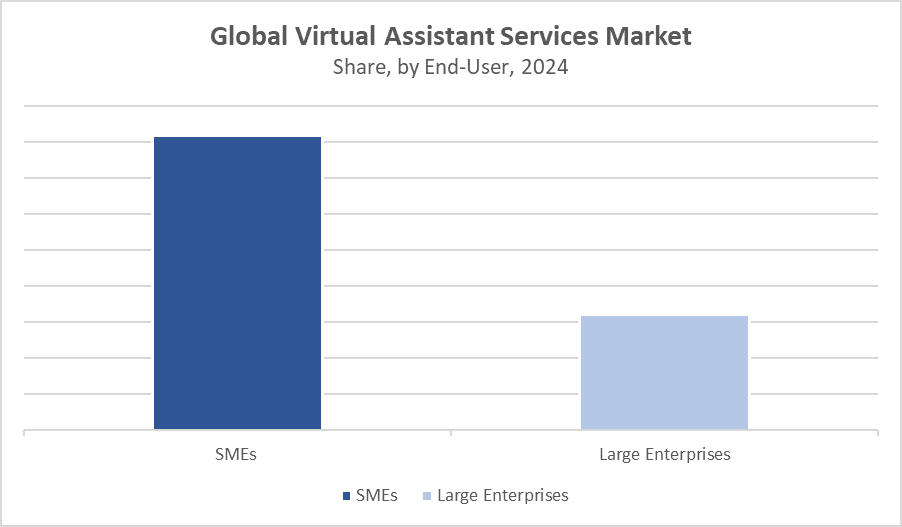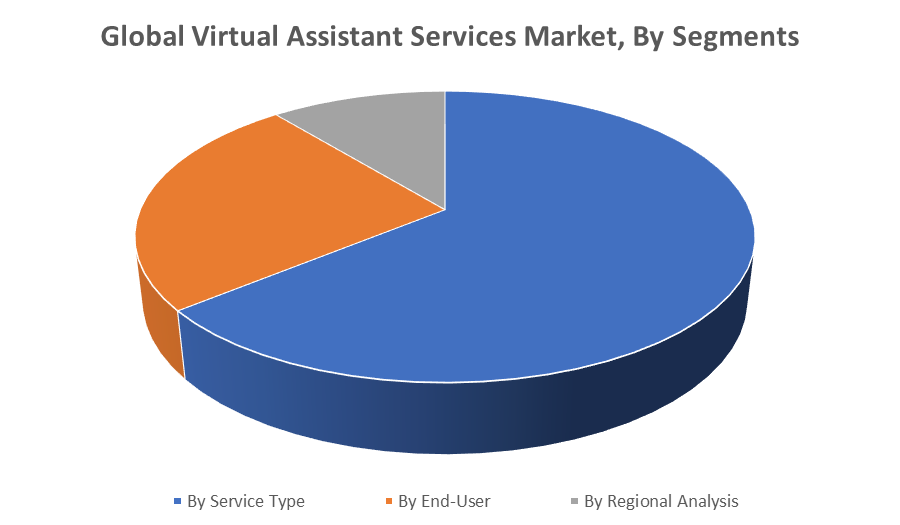Global Virtual Assistant Services Market
Global Virtual Assistant Services Market Size, Share, and COVID-19 Impact Analysis, Impact of Tariff and Trade War Analysis, By Service Type (Conversational Interfaces, Administrative Support, and Customer Engagement), By End-User (SMEs and Large Enterprises), and By Region (North America, Europe, Asia-Pacific, Latin America, Middle East, and Africa), Analysis and Forecast 2025 - 2035
Report Overview
Table of Contents
Virtual Assistant Services Market Size Summary, Size & Emerging Trends
- According to Decisions Advisors, The Global Virtual Assistant Services Market Size is expected to Grow from USD 10.23 Billion in 2024 to USD 38.46 Billion by 2035, at a CAGR of 5.7% during the forecast period 2025-2035.
- Rising demand for automation in customer service, cost efficiency in business processes, and increased remote working are key driving factors for the virtual assistant services market.

Key Market Insights
- North America is expected to account for the largest share in the virtual assistant services market during the forecast period.
- In terms of service type, the conversational interfaces segment dominated in terms of revenue during the forecast period.
- In terms of end-user, the SMEs segment accounted for the largest revenue share in the global virtual assistant services market during the forecast period.
Global Market Forecast and Revenue Outlook
- 2024 Market Size: USD 10.23 Billion
- 2035 Projected Market Size: USD 38.46 Billion
- CAGR (2025-2035): 5.7%
- North America: Largest market in 2024
- Asia Pacific: Fastest growing market
Virtual Assistant Services Market
The virtual assistant services market focuses on delivering AI-driven and human-supported solutions that help businesses streamline various operations. These services are widely used across industries for tasks such as customer support, scheduling appointments, administrative work, and lead generation. The market’s growth is propelled by the increasing adoption of remote work, advancements in AI technologies, and the growing need for round-the-clock service availability. Both governments and large corporations are investing heavily in AI-based productivity tools to boost efficiency while cutting labor costs. As digital transformation accelerates globally, virtual assistant services have become essential for enhancing user experience, automating repetitive tasks, and enabling businesses to scale their operations effectively. This market is positioned for significant expansion as organizations seek smarter, cost-effective ways to manage customer interactions and internal processes.
Virtual Assistant Services Market Trends
- There is a growing push toward AI–human hybrid models for improved personalization and reliability.
- Advances in natural language processing (NLP) are enabling more accurate and contextual interactions.
- Startups and SMEs are adopting virtual assistant services to reduce operational overhead.
Virtual Assistant Services Market Dynamics
Driving Factors: The virtual assistant services market is driven by the growing demand for automation and operational efficiency across industries
The virtual assistant services market is driven by the growing demand for automation and operational efficiency across industries. Increasing adoption of AI-powered tools enables businesses to offer 24/7 customer support at a lower cost. Outsourcing support functions to virtual assistants reduces overhead and improves scalability. The widespread shift to remote and hybrid work environments further fuels demand for virtual assistants that can handle multiple tasks seamlessly. These factors collectively push businesses to invest more in virtual assistant services to streamline workflows, enhance customer experience, and maintain competitive advantage in a rapidly evolving digital landscape.
Restrain Factors: Virtual assistants often struggle with understanding complex or nuanced queries
Despite growth, the market faces restraints such as concerns over data security and service quality. Virtual assistants often struggle with understanding complex or nuanced queries, limiting their effectiveness. Industries like healthcare and finance are particularly sensitive to data privacy, raising compliance challenges. Additionally, the reliance on robust internet infrastructure means inconsistent connectivity can disrupt service delivery. These factors contribute to hesitancy in adoption and restrict market expansion. Ensuring secure handling of sensitive information and improving AI comprehension are critical hurdles that service providers must overcome to build trust and wider acceptance.
Opportunity: Emerging opportunities lie in industry-specific virtual assistant services tailored to sectors like healthcare
Emerging opportunities lie in industry-specific virtual assistant services tailored to sectors like healthcare, legal, and e-commerce. These specialized assistants can handle unique workflows and compliance requirements, unlocking new revenue streams. Enterprises are also adopting multilingual and voice-activated assistants to reach broader, diverse customer bases. The rise of natural language processing and AI improvements allows virtual assistants to provide more personalized, context-aware interactions. This customization enhances user experience and opens doors for virtual assistant adoption in untapped markets. Expanding into niche verticals and leveraging advanced technologies represent significant growth avenues for providers.
Challenges: Striking a balance between automated service and human empathy remains difficult
The market faces challenges, including a shortage of skilled talent to develop and maintain virtual assistant solutions. Integrating these assistants with existing legacy systems is complex and costly, often requiring significant upfront investment. Additionally, striking a balance between automated service and human empathy remains difficult; over-automation can alienate users, while too much human intervention reduces cost efficiency. Continuous AI training and refining workflows are necessary but resource-intensive. Providers must innovate to overcome these technical and operational barriers, ensuring virtual assistants deliver effective, secure, and user-friendly support to sustain market growth.
Global Virtual Assistant Services Market Ecosystem Analysis
The global virtual assistant services market ecosystem comprises AI technology providers, BPO companies, cloud platform operators, and end users across sectors like e-commerce, healthcare, IT, and finance. Innovation in AI and scalable cloud infrastructure fuels this ecosystem, enabling efficient, flexible solutions. Increasing digital maturity among enterprises drives adoption, while vendors compete by offering superior integration, customization, and strong security compliance. This dynamic collaboration ensures continuous improvement, meeting diverse industry needs and supporting the expanding demand for virtual assistant services worldwide.
Global Virtual Assistant Services Market, By Service Type
The conversational interfaces segment dominated the virtual assistant services market in terms of revenue during the forecast period, capturing approximately 60% of the total market share. This dominance is driven by the growing preference for natural, interactive communication between users and virtual assistants. Conversational interfaces, including chatbots and voice assistants, offer seamless user experiences across customer service, sales, and support functions. Their ability to handle complex queries and provide personalized responses boosts adoption across industries, making this segment the largest revenue contributor throughout the forecast period.
The administrative support segment accounted for the second-largest share in the virtual assistant services market, holding around 25% of the total revenue during the forecast period. This segment includes tasks like scheduling, data management, and email handling, which are increasingly outsourced to virtual assistants to improve efficiency and reduce operational costs. The rising need for streamlined administrative processes in businesses of all sizes drives demand in this segment, making it a significant contributor to the overall market revenue after the leading Conversational Interfaces segment.
Global Virtual Assistant Services Market, By End-User
The SMEs segment held the largest revenue share in the global virtual assistant services market, accounting for about 55% during the forecast period. Small and medium-sized enterprises increasingly adopt virtual assistant services to enhance operational efficiency, reduce costs, and improve customer engagement without heavy investments in full-time staff. The flexibility and scalability of these services make them ideal for SMEs looking to compete with larger companies. This strong adoption drives the segment’s dominant position in market revenue throughout the forecast period.

The large enterprises segment is witnessing significant adoption in the virtual assistant services market, capturing around 35% of the total revenue share during the forecast period. Large organizations are increasingly leveraging virtual assistants to automate complex workflows, enhance customer support, and improve operational efficiency at scale. Their substantial budgets and focus on digital transformation drive the demand for advanced, customized virtual assistant solutions, making this segment a key contributor to the overall market growth alongside SMEs.
North America’s dominance in the virtual assistant services market.
The region’s mature digital infrastructure supports seamless integration of virtual assistant technologies across sectors like healthcare, finance, retail, and IT services. Additionally, a strong focus on innovation, research, and development accelerates the rollout of advanced features such as natural language processing and machine learning, driving higher adoption rates. Regulatory frameworks also encourage the responsible use of AI, fostering trust among businesses and consumers.
Asia Pacific’s rapid market growth
Is largely driven by its large and digitally savvy population, especially in countries like India and China. The proliferation of smartphones and affordable internet access enables widespread use of virtual assistants, especially among SMEs looking to optimize operations cost-effectively. Governments in the region actively promote digital initiatives and AI innovation, creating favorable conditions for market expansion. Additionally, rising investments in cloud infrastructure and tech startups enhance the availability of advanced virtual assistant solutions tailored to diverse languages and cultural contexts, increasing adoption rates.
Europe’s steady growth
Is supported by increasing digital maturity and AI adoption across industries such as automotive, manufacturing, and banking. The European Union’s emphasis on data privacy and security, through regulations like GDPR, pushes vendors to develop compliant, secure virtual assistant platforms. This regulatory rigor builds customer confidence and encourages adoption. Furthermore, collaboration between governments and private sectors fosters innovation hubs and funding for AI research, which contribute to the gradual but consistent expansion of virtual assistant services.
WORLDWIDE TOP KEY PLAYERS IN THE VIRTUAL ASSISTANT SERVICES MARKET INCLUDE
- Upwork Inc.
- TaskBullet
- Wing Assistant
- Time Etc
- Magic
- 24/7 Virtual Assistant
- Prialto
- MyOutDesk
- Uassist.ME
- Others
Product Launches in Virtual Assistant Services Market
- In June 2024, Wing Assistant launched a new multilingual voice assistant designed specifically for the real estate and healthcare sectors. This innovative solution aims to improve communication and streamline operations by supporting multiple languages, making it easier for businesses in these industries to serve diverse customer bases and manage complex workflows efficiently.
- In July 2024, Prialto enhanced its virtual executive assistant services by integrating AI-enabled task automation tools. This expansion allows executives to automate routine tasks, increasing productivity and enabling more focus on strategic activities. The AI capabilities help streamline workflows and improve overall efficiency for clients.
Market Segment
This study forecasts revenue at global, regional, and country levels from 2020 to 2035. Decisions Advisors has segmented the virtual assistant services market based on the below-mentioned segments:

Global Virtual Assistant Services Market, By Service Type
- Conversational Interfaces
- Administrative Support
- Customer Engagement
Global Virtual Assistant Services Market, By End-User
- SMEs
- Large Enterprises
Global Virtual Assistant Services Market, By Regional Analysis
- North America
- US
- Canada
- Mexico
- Europe
- Germany
- UK
- France
- Italy
- Spain
- Russia
- Rest of Europe
- Asia Pacific
- China
- Japan
- India
- South Korea
- Australia
- Rest of Asia Pacific
- South America
- Brazil
- Argentina
- Rest of South America
- Middle East & Africa
- UAE
- Saudi Arabia
- Qatar
- South Africa
- Rest of the Middle East & Africa
Check Licence
Choose the plan that fits you best: Single User, Multi-User, or Enterprise solutions tailored for your needs.
We Have You Covered
- 24/7 Analyst Support
- Clients Across the Globe
- Tailored Insights
- Technology Tracking
- Competitive Intelligence
- Custom Research
- Syndicated Market Studies
- Market Overview
- Market Segmentation
- Growth Drivers
- Market Opportunities
- Regulatory Insights
- Innovation & Sustainability
Report Details
| Pages | 180 |
| Delivery | PDF & Excel via Email |
| Language | English |
| Release | Sep 2025 |
| Access | Download from this page |
